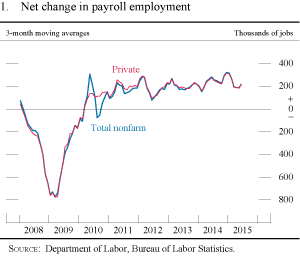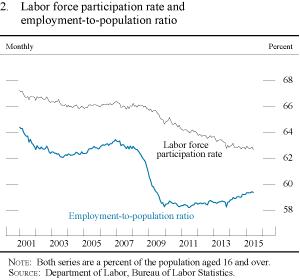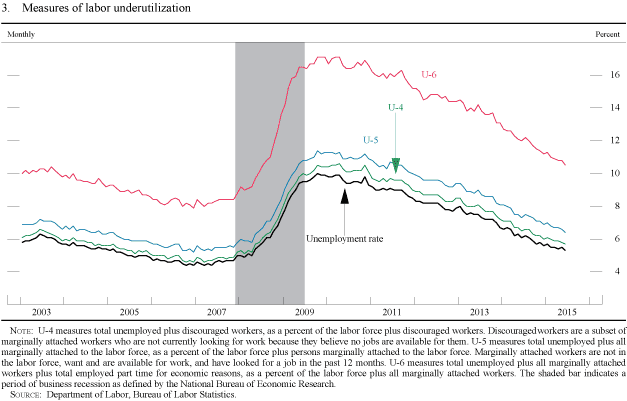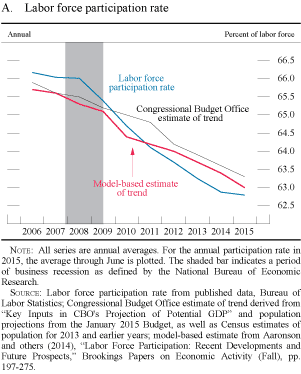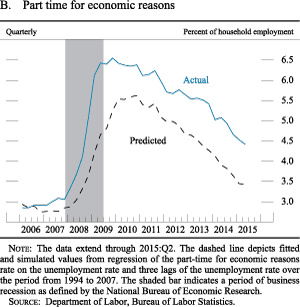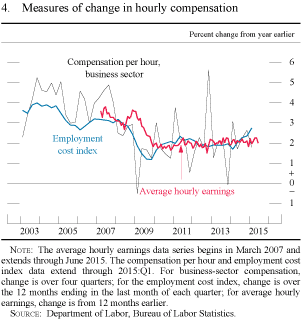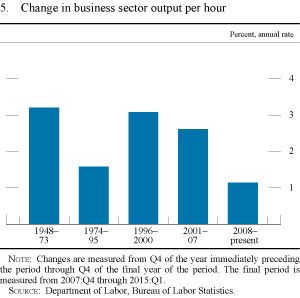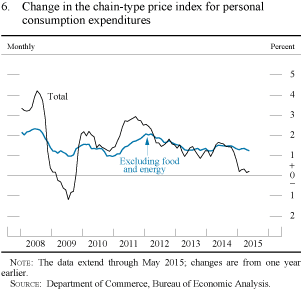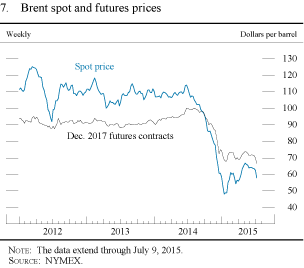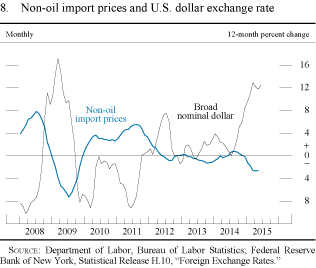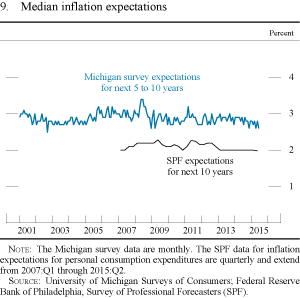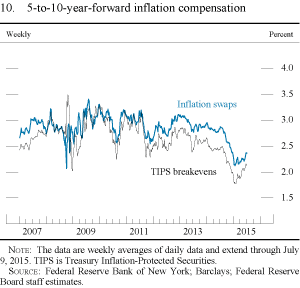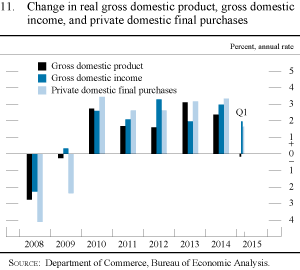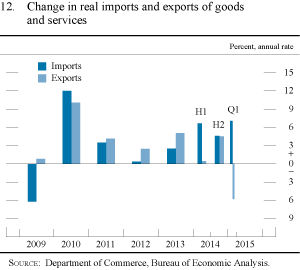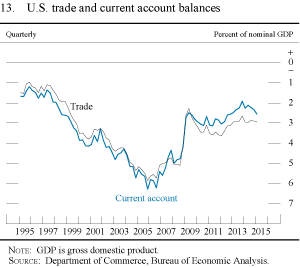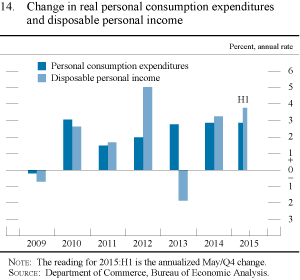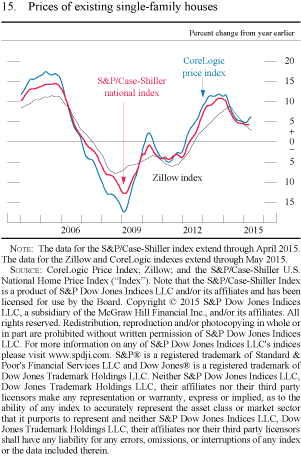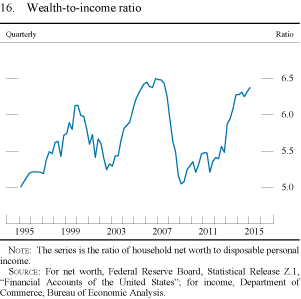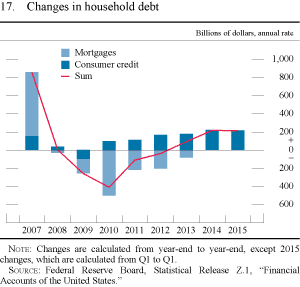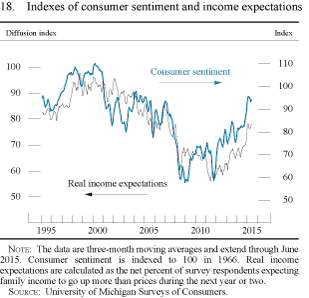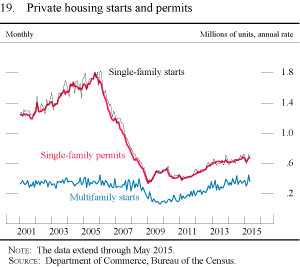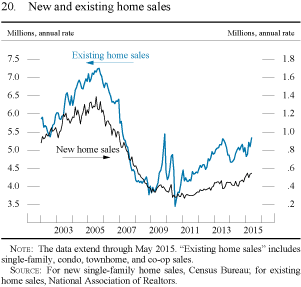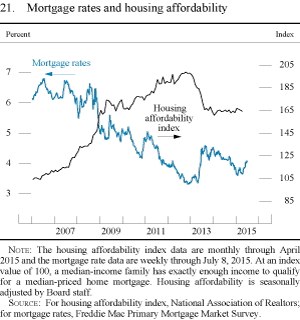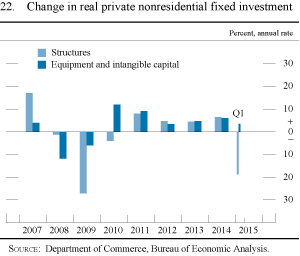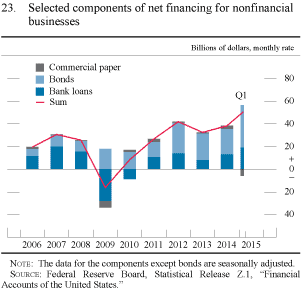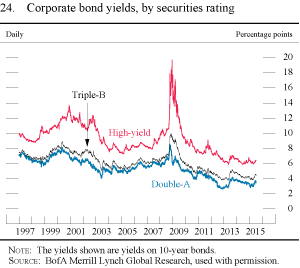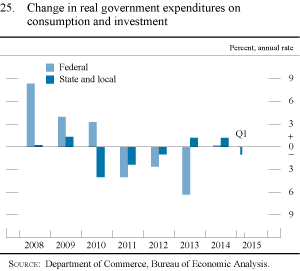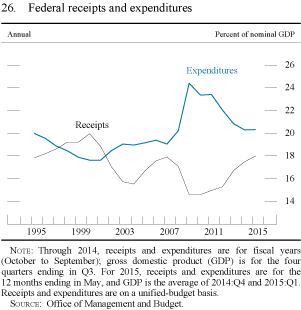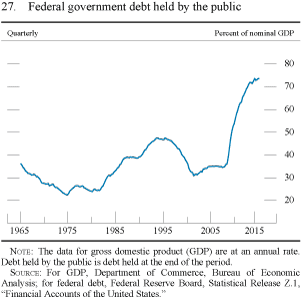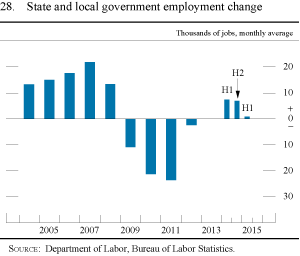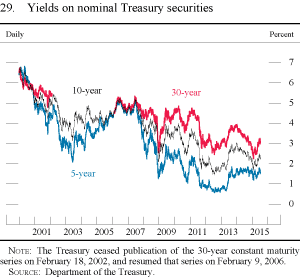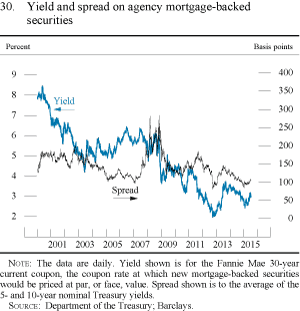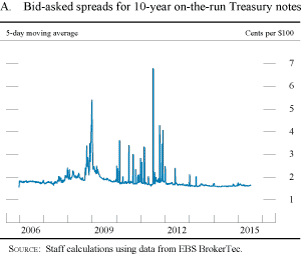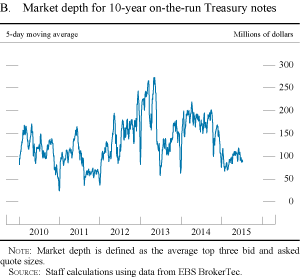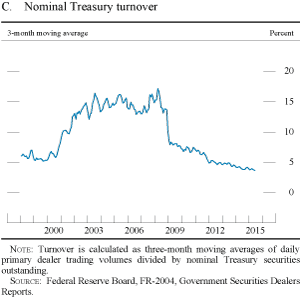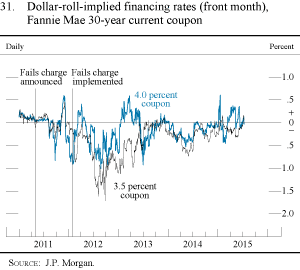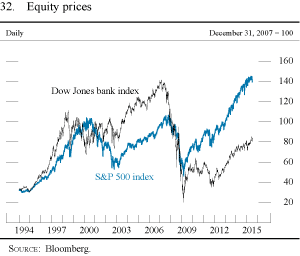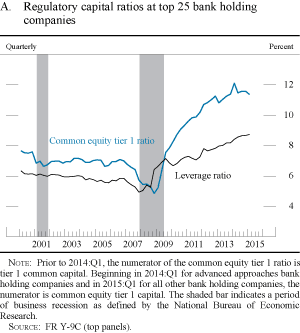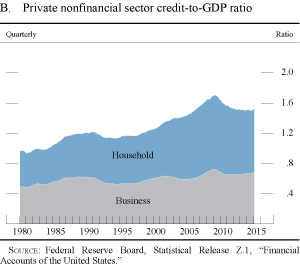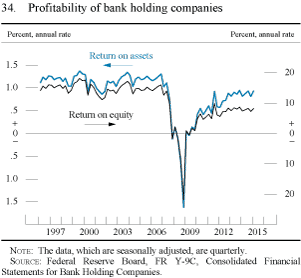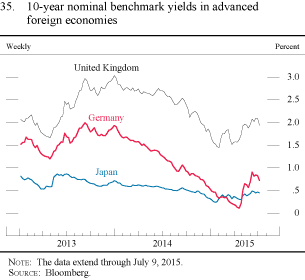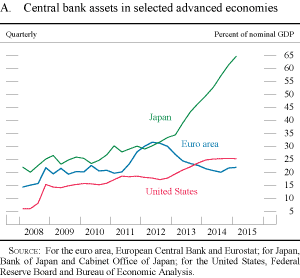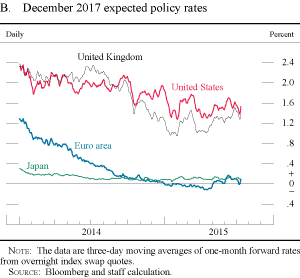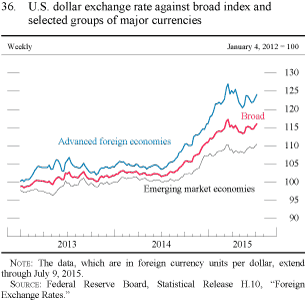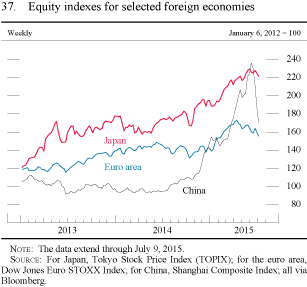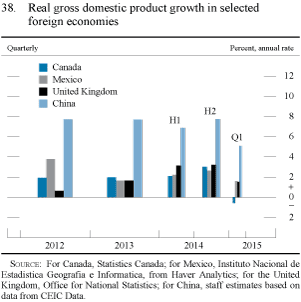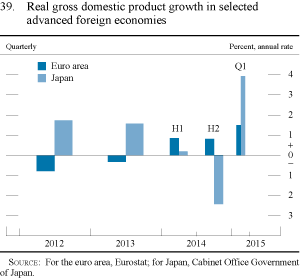- July 15, 2015: Summary
- Part 1
- Part 2
- Part 3
- Abbreviations
- Printable Version (1.32 MB PDF)

Sections of Part 1
Part 1: Recent Economic and Financial Developments
Monetary Policy Report submitted to the Congress on July 15, 2015, pursuant to section 2B of the Federal Reserve ActLabor market conditions continued to improve over the first half of 2015, although at a more moderate pace than last year. Gains in payroll employment since the start of the year have averaged close to 210,000 per month, somewhat below last year's average pace, while the unemployment rate edged down slightly to 5.3 percent in June, close to most Federal Open Market Committee (FOMC) participants' estimates of its longer-run normal level. Since last summer, a steep drop in crude oil prices has exerted downward pressure on overall inflation, and price increases for other goods and services have been subdued, partly reflecting declines in prices for imported non-energy goods. The price index for personal consumption expenditures (PCE) increased only 1/4 percent during the 12 months ending in May, a rate that is well below the FOMC's longer-run objective of 2 percent; the index excluding food and energy prices was up 1-1/4 percent over this period. Survey-based measures of longer-run inflation expectations have been fairly stable, whereas measures of inflation compensation derived from financial market quotes, while up from their lows earlier this year, remain below the levels that prevailed prior to last summer. Meanwhile, real gross domestic product (GDP) was reported to have been little changed in the first quarter of this year. Some of this weakness likely was the result of temporary factors, and recent indicators suggest that economic activity picked up in the second quarter; even so, the pace of output growth appears to have slowed so far this year, on average, relative to its pace last year. The economic expansion continues to be supported by rising real incomes driven by gains in employment and, recently, lower oil prices; by improving consumer and business confidence; and by accommodative monetary policy and generally favorable financial conditions. However, the low level of oil prices also pushed down investment spending in the energy sector early this year, and sluggish growth abroad and the higher foreign exchange value of the dollar have weighed on U.S. exports.
Domestic Developments
The labor market has continued to improve but at a more gradual pace...
Labor market conditions strengthened further over the first half of 2015 but at a more moderate pace than last year. Payroll employment gains have averaged about 210,000 per month so far this year, a solid pace but down from an average of 260,000 jobs per month in 2014 (figure 1). The unemployment rate has continued to edge lower and reached 5.3 percent in June, 1/4 percentage point lower than in December; in 2014, the unemployment rate declined more rapidly. In addition, the share of unemployed who have been out of work for more than six months has declined noticeably this year. After falling steeply during the recession and the early part of the recovery, the labor force participation rate has remained roughly flat since late 2013, although it ticked lower in June (figure 2). The continued stability of the participation rate likely represents cyclical improvement relative to its declining trend, which reflects ongoing demographic trends such as the aging of members of the baby-boom generation into their retirement years. With employment rising and the participation rate holding steady, the employment-to-population ratio edged up further over the first half of this year. Furthermore, the job openings rate has continued to move up this year and now stands above its pre-recession level, and the quits rate, which is often considered a measure of workers' confidence in labor market opportunities, has remained at relatively high levels. Unemployment insurance claims are now very low.
...and some labor market slack remains...
With these improvements, the labor market has shown further progress toward the Committee's maximum employment mandate. Nevertheless, as described in the box "Slack in the Labor Market," other labor market indicators are consistent with more slack in resource utilization than is indicated by the unemployment rate alone. In particular, although these measures have improved, the participation rate remains below most assessments of its trend, and the share of workers who are employed part time but would like to work full time is still high; in large part for this reason, the more comprehensive U-6 measure of labor underutilization remains elevated relative to the unemployment rate (figure 3).
Slack in the Labor Market
Gauging how far the economy is from the Federal Reserve's congressionally mandated objective of maximum employment--that is, estimating the amount of slack (or underutilized resources) in the labor market--is of central importance for monetary policy decisions. The most common and straightforward measure of labor market slack is the unemployment rate gap--the deviation of the unemployment rate from its longer-run sustainable level, or natural rate. By this measure, labor slack has narrowed significantly, and, according to many estimates of the natural rate, the economy may be near maximum employment. However, other measures of labor utilization--including the labor force participation rate and the share of workers employed part time who would like to work full time--have shown less improvement and may represent additional margins of labor market slack that should be considered when assessing progress toward maximum employment.
The natural rate of unemployment is unobserved and necessarily uncertain. At present, most Federal Open Market Committee (FOMC) participants estimate the longer-run normal level of the unemployment rate to be between 5.0 and 5.2 percent, while the Congressional Budget Office's (CBO) current estimate of the natural rate is 5.4 percent.1 The natural rate is thought to be influenced by frictions in the labor market that prevent firms and workers from quickly forming employment relationships, and some analysts have suggested that these frictions have increased since the Great Recession because of a greater mismatch between the skills demanded by firms and those provided by job seekers or because long spells of unemployment have made some job seekers less employable.2 Others have argued that these factors do not necessarily imply a higher natural rate of unemployment.3 Moreover, the natural rate may have fallen in recent years because of a shift in the composition of the labor force toward individuals with lower average unemployment rates.4
Even if we could accurately measure the natural rate, the unemployment rate gap may at times be an insufficient measure of slack. The measured unemployment rate includes only persons who do not have a job, are available to work, and are actively looking for a job. It excludes persons who may want a job but are not actively searching; these individuals are counted as being out of the labor force instead. The labor force participation rate (the fraction of the population either employed or counted as unemployed) has fallen steeply since the start of the recession. Much of this decline--at least half, by many estimates--likely reflects demographic changes, and another portion of the decline may be related to developments that have contributed to longer-run secular declines in labor force participation among younger adults and working-age men; the portion of the decline due to these factors likely would have occurred even in the absence of a recession. However, the severity of the Great Recession and, especially, the sluggishness of the recovery may nonetheless have discouraged many more persons from looking for work and thus contributed to the steep decline in the participation rate in recent years.5
Figure A plots the actual participation rate against estimates of its trend level from the CBO and from a model developed by Federal Reserve System staff and featured in the fall 2014 edition of the Brookings Papers on Economic Activity.6 Both estimates of the trend capture the influences of demographics and long-running secular changes on the participation rate. Using either estimate, the actual participation rate is at present further below its trend than would be expected given the unemployment rate gap. As a result, at present the unemployment rate gap may understate how much slack remains in the labor market. As job prospects improve further, the participation rate should continue to converge toward its trend, and this excess slack should also diminish.
Additionally, the fraction of workers who report working part time but who want a full-time job (the share of people working part time for economic reasons, or the PTER rate) remains higher than would be expected given other measures of labor market utilization. For example, figure B plots the PTER rate with a prediction of what the PTER rate would be if it moved with the unemployment rate in its historically typical fashion. Although the PTER rate has declined somewhat as the unemployment rate has fallen, it remains higher than would be expected given the current level of the unemployment rate. As with the participation rate, some of the movement in the PTER rate may reflect a longer-term trend--such as a shift in employment toward service-producing industries, which tend to employ more part-time workers as a share of their workforce.7 However, the share of involuntary part-time workers remains elevated in most industries and for most demographic groups, suggesting that at least some of the still-elevated PTER rate is due to weak labor demand. If so, then involuntary part-time workers represent another margin of labor market slack not captured by the unemployment rate.
To be sure, there is considerable uncertainty about the magnitude of any additional labor market slack represented by each of these elements. However, it seems likely that they do reflect additional slack not measured by the unemployment rate, which should also be considered when judging how far employment is from its maximum sustainable level.
Footnotes
1. The FOMC participants' estimate is the central tendency of the longer-run unemployment rate as presented in the Summary of Economic Projections that is included as Part 3 of this report. The full range of participants' estimates is from 5.0 to 5.8 percent. Estimates from the CBO are provided in Congressional Budget Office (2015), The Budget and Economic Outlook: 2015 to 2025 (Washington: CBO, January), www.cbo.gov/publication/49892. Return to text
2. One study estimates that the efficiency of job matching deteriorated during the recession and, by 2012, had recovered only incompletely; see Regis Barnichon and Andrew Figura (forthcoming), "Labor Market Heterogeneity and the Aggregate Matching Function," American Economic Journal: Macroeconomics. Another study argues that the long-term unemployed will continue to have a low likelihood of finding employment; see Alan B. Krueger, Judd Cramer, and David Cho (2014), "Are the Long-Term Unemployed on the Margins of the Labor Market?" Brookings Papers on Economic Activity, vol. 48 (Spring), pp. 229-99, www.brookings.edu/~/media/Projects/BPEA/Spring-2014/2014a_Krueger.pdf?la=en ![]() . Return to text
. Return to text
3. As evidence of less efficient matching, some analysts point to the elevated level of job vacancies relative to unemployed persons. However, vacancies may also be elevated because it has become more profitable for firms to post vacancies as labor's share of income has declined, as shown in Andrew Figura and David Ratner (2015), "The Labor Share of Income and Equilibrium Unemployment," FEDS Notes (Washington: Board of Governors of the Federal Reserve System, June 8), www.federalreserve.gov/econresdata/notes/feds-notes/2015/labor-share-of-income-and-equilibrium-unemployment-20150608.html. For evidence supporting the view that the long-term unemployed may be no less employable than the short-term unemployed because both the long- and short-term unemployed tend to have the same influence on wages, see Christopher Smith (2014), "The Effect of Labor Slack on Wages: Evidence from State-Level Relationships," FEDS Notes (Washington: Board of Governors of the Federal Reserve System, June 2), www.federalreserve.gov/econresdata/notes/feds-notes/2014/effect-of-labor-slack-on-wages-evidence-from-state-level-relationships-20140602.html. Return to text
4. Demographic changes, all else being equal, would push down the natural rate relative to its pre-recession level, as shown in Daniel Aaronson, Luojia Hu, Arian Seifoddini, and Daniel G. Sullivan (2014), "Declining Labor Force Participation and Its Implications for Unemployment and Employment Growth," Federal Reserve Bank of Chicago, Economic Perspectives, vol. 38 (Fourth Quarter), pp. 100-38, https://www.chicagofed.org/publications/economic-perspectives/2014/4q-aaronson-etal ![]() . Return to text
. Return to text
5. For a discussion of secular trends in labor force participation that predated the recession, see Stephanie Aaronson, Tomaz Cajner, Bruce Fallick, Felix Galbis-Reig, Christopher L. Smith, and William Wascher (2014), "Labor Force Participation: Recent Developments and Future Prospects," Brookings Papers on Economic Activity (Fall), pp. 197-275, www.brookings.edu/~/media/Projects/BPEA/Fall-2014/Fall2014BPEA_Aaronson_et_al.pdf?la=en ![]() . For evidence suggesting that the decline predominantly reflects weak labor demand, see Christopher J. Erceg and Andrew T. Levin (2014), "Labor Force Participation and Monetary Policy in the Wake of the Great Recession," Journal of Money, Credit and Banking, vol. 46 (October), pp.3-49. Return to text
. For evidence suggesting that the decline predominantly reflects weak labor demand, see Christopher J. Erceg and Andrew T. Levin (2014), "Labor Force Participation and Monetary Policy in the Wake of the Great Recession," Journal of Money, Credit and Banking, vol. 46 (October), pp.3-49. Return to text
6. Model estimates refer to published estimates from Aaronson and others, "Labor Force Participation: Recent Developments," in note 5; estimates from the CBO are derived from supplementary economic data and projections in Congressional Budget Office, Budget and Economic Outlook, in note 1. Return to text
7. See Rob Valletta and Catherine van der List (2015), "Involuntary Part-Time Work: Here to Stay?" FRBSF Economic Letter 2015-19 (San Francisco: Federal Reserve Bank of San Francisco, June 8), www.frbsf.org/economic-research/publications/economic-letter/2015/june/involuntary-part-time-work-labor-market-slack-post-recession-unemployment ![]() ; and Tomaz Cajner, Dennis Mawhirter, Christopher Nekarda, and David Ratner (2014), "Why Is Involuntary Part-Time Work Elevated?" FEDS Notes (Washington: Board of Governors of the Federal Reserve System, April 14), www.federalreserve.gov/econresdata/notes/feds-notes/2014/why-is-involuntary-part-time-work-elevated-20140414.html. Return to text
; and Tomaz Cajner, Dennis Mawhirter, Christopher Nekarda, and David Ratner (2014), "Why Is Involuntary Part-Time Work Elevated?" FEDS Notes (Washington: Board of Governors of the Federal Reserve System, April 14), www.federalreserve.gov/econresdata/notes/feds-notes/2014/why-is-involuntary-part-time-work-elevated-20140414.html. Return to text
...while compensation has shown some signs of accelerating...
As the labor market has continued to improve, increases in some measures of hourly labor compensation have begun to pick up but, nonetheless, remain relatively subdued. The employment cost index (ECI) for private-industry workers, which measures both wages and the cost of employer-provided benefits, rose 2-3/4 percent over the 12 months ending in March, up from gains of about 2 percent that had prevailed over the past few years (figure 4). Two other prominent measures of compensation--average hourly earnings and business-sector compensation per hour--have increased a bit more slowly than the ECI over the past year and have shown little sign of acceleration. Since the recession began, the gains in all three of these measures of nominal compensation have fallen well short of their pre-recession averages, and growth of real compensation has fallen short of productivity growth over much of this period. That said, the drop in energy prices boosted real wage growth over the past year.
...and productivity growth has been especially weak
Labor productivity in the business sector is reported to have declined in both the fourth quarter of 2014 and the first quarter of 2015, as the recovery in hours worked progressed even as output growth slowed. Over such short periods, however, productivity growth is often quite volatile, both because of difficulties in measuring output and hours and because other transitory factors may affect productivity growth from quarter to quarter. Taking a longer view, output per hour in the business sector has risen at an average annual rate of 1-1/4 percent since the recession began in late 2007, a gain that is modest by historical standards (figure 5). The relatively slow pace of productivity growth since 2007 reflects, in part, the sustained weakness in capital investment over the recession and recovery period; consequently, productivity gains may improve in the future as investment in productivity-enhancing capital equipment and research and development strengthens.
A plunge in crude oil prices has held down consumer prices...
Overall consumer price inflation has slowed to near zero over the past year, well below the FOMC's longer-run objective of 2 percent. In May, the 12-month change in the overall PCE price index was only 1/4 percent, down from 1-3/4 percent in May 2014 (figure 6). This deceleration importantly reflects the sharp drop in oil and farm commodity prices over this period as well as declines in non-energy import prices. However, energy prices have stabilized in recent months, with the result that one-month changes in overall PCE prices have firmed somewhat.
After plunging in the second half of 2014, the spot price of crude oil moved up somewhat in the first half of 2015, reflecting in part a sharp decline in investment in the U.S. energy sector. Over the past few weeks, prices have moved lower as both U.S. and foreign oil production have been stronger than expected and as concerns about global growth persist. As of early July, at below $60 per barrel, the spot price of Brent crude oil remains at about half of its mid-2014 peak (figure 7). Moreover, oil futures prices suggest that market participants expect only a moderate increase in oil prices over the next couple of years as global demand firms and North American supply growth slows. The large cumulative drop in crude oil prices was fully passed through to lower retail prices for gasoline and other energy products early this year. More recently, gasoline prices have increased somewhat, although prices at the pump remain at levels substantially below those of last summer.
Food commodity prices have fallen considerably from their levels of a year ago, and the gradual pass-through of these costs to the retail level has led to declines in consumer food prices over the first five months of this year. Meanwhile, non-oil import prices have been declining sharply so far this year, reflecting lower commodity prices as well as the rise since last summer in the exchange value of the dollar (figure 8).
...and outside of the energy and food categories, inflation has remained subdued
Inflation for items other than food and energy (so-called core inflation) has remained relatively low. Core PCE prices rose about 1-1/4 percent over the 12 months ending in May, down slightly from its year-earlier pace. Falling import prices likely held down core inflation over the past year, and lower oil prices and easing prices for commodities more generally may have played a role in holding down firms' costs and prices. In addition, ongoing slack in labor and product markets has likely placed downward pressure on inflation, although with the improving labor market, the effect of this factor likely is waning.
Survey-based measures of longer-term inflation expectations have remained stable...
Because inflation expectations likely factor into wage- and price-setting decisions, the Federal Reserve tracks a variety of indicators of these expectations. Survey-based measures of longer-term inflation expectations have been quite stable over the past 15 years. Readings on inflation expectations over the next 5 to 10 years, as reported in the University of Michigan Surveys of Consumers, have continued to move within a narrow range, and, in the Survey of Professional Forecasters, conducted by the Federal Reserve Bank of Philadelphia, the median expectation for the annual rate of increase in the PCE price index over the next 10 years has been unchanged at 2 percent (figure 9). Furthermore, in the Survey of Primary Dealers, conducted by the Federal Reserve Bank of New York, distributions of inflation expectations 5 to 10 years ahead have also remained stable.
...while market-based measures of inflation compensation have declined since last summer
In contrast, market-based measures of longer-term inflation compensation--derived from inflation swaps or from differences between yields on nominal Treasury securities and Treasury Inflation-Protected Securities (TIPS)--declined noticeably between the middle of 2014 and early this year, and, while they have retraced part of that decline in recent months, they remain below the levels that prevailed prior to last summer (figure 10). Deducing the sources of changes in inflation compensation is difficult because such movements reflect not only expected inflation, but also an inflation risk premium--the compensation that holders of nominal securities demand for bearing inflation risk--as well as other factors. Nevertheless, one cannot rule out a decline in inflation expectations among market participants since last summer.
Economic activity slowed earlier this year
Real GDP is reported to have been little changed in the first quarter of this year after increasing 2-1/2 percent in 2014 (figure 11). Some of this weakness likely reflected temporary disruptions due to unusually severe winter weather and a labor dispute at West Coast ports; in addition, residual seasonality in some components of GDP may have held down measured first-quarter growth.1 Both of these factors would tend to boost measured GDP growth over the remainder of the year. Indeed, a number of recent spending indicators suggest that economic activity rose moderately in the second quarter.
However, some of the slowdown in GDP growth relative to its pace last year likely reflects somewhat more persistent factors. In particular, expectations that the relative strength of the U.S. economy will lead to an earlier normalization of monetary policy than in our trading partners have contributed to a substantial appreciation of the dollar over the past year. The appreciation, combined with sluggish foreign growth, is weighing on the demand for U.S. exports. And the sizable drop in oil prices since last summer has led to marked cutbacks in investment in the energy sector of our economy even though those price declines have been a substantial benefit to households. These factors also contributed to the 2-3/4 percent annual rate of decline in industrial production in the first five months of this year. Despite the drag on production from these headwinds, the economic expansion continues to be supported by accommodative financial conditions--including the low cost of borrowing for many households and businesses--and by increases in households' real incomes spurred by continuing job gains and the earlier decline in oil prices.
Net exports were a substantial drag on real GDP growth in the first quarter
Exports fell markedly in the first quarter, held back by lackluster growth abroad, the appreciation of the dollar, and transitory factors, including the West Coast port labor dispute (figure 12). In contrast, imports grew briskly in the first quarter, supported in part by the stronger dollar. As a result, net exports were an unusually large drag on real GDP growth. Trade data through May suggest that exports recovered from their first-quarter drop and import growth slowed, pointing to a small negative contribution from net exports in the second quarter. The current account deficit widened a bit to 2.6 percent of nominal GDP in the first quarter of this year but remains near its narrowest readings since the late 1990s (figure 13).
Gains in income and wealth are supporting consumer spending...
The rate of growth in consumer spending slowed during this year's harsh winter but has picked up in recent months. Smoothing through these monthly fluctuations, real consumer spending increased at an average annual rate of 2-3/4 percent over the first five months of this year, about the same as its average pace over 2014 (figure 14). The ongoing improvement in the labor market has supported income growth, and low gasoline prices have boosted households' purchasing power. As a result, real disposable personal income--that is, income after taxes and adjusted for price changes--increased at an annual rate of nearly 4 percent over the first five months of this year, a slightly faster pace than in 2014.
Coupled with low interest rates, the rise in incomes has reduced debt payment burdens for many households. The household debt service ratio--that is, the ratio of required principal and interest payments on outstanding household debt to disposable personal income--has remained at a very low level by historical standards.
Consumer spending growth also continues to be supported by increases in household net worth. Over the first half of this year, broad measures of U.S. equity prices were little changed, on balance, after having risen considerably in recent years, and house prices moved up further (figure 15). Buoyed by cumulative increases in home and equity prices, aggregate household net worth has risen appreciably from its levels during the recession and its aftermath to more than six times the value of disposable personal income (figure 16).
...as is credit availability for consumers that remains generally favorable
Consumer credit has continued to expand this year (figure 17). Auto and student loans remain widely available even to borrowers with lower credit scores, and outstanding balances of such loans expanded significantly through May. Credit card borrowing slowed early this year, likely reflecting weak retail activity, but has rebounded in recent months. However, credit card availability remains unusually tight for borrowers with below-prime credit scores.
Consumer confidence remains high
Indicators of consumer sentiment suggest that confidence among households remains high. The Michigan survey's index of consumer sentiment--which incorporates households' views about their own financial situations as well as broader economic conditions--moved up noticeably over the second half of 2014 as oil prices plunged and labor market conditions improved and has remained upbeat so far this year (figure 18). Responses to the Michigan survey's question about households' expectations of real income changes over the next year or two have also moved up over the past year to their highest levels since before the recession.
The pace of homebuilding has improved only slowly
The recovery in residential investment continued at a gradual pace over the first half of this year. Smoothing through the effects of harsh winter weather, single-family housing starts have edged up since last summer, while sales of new and existing homes have been trending up, on balance, over the past year (figures 19 and 20). In addition, multifamily construction activity has recovered to its pre-recession level, reflecting a shift in demand toward rental units. All told, real residential investment looks set to post a moderate gain over the first half of the year. Nevertheless, overall construction activity remains well below its pre-recession levels, likely due to a rate of household formation that, notwithstanding tentative signs of a recent pickup, has generally run quite low relative to demographic norms since the recession.
The slow advances in single-family construction and home sales have likely been supported, at least to some degree, by low interest rates and a gradual easing in mortgage credit. In the April Senior Loan Officer Opinion Survey on Bank Lending Practices (SLOOS), banks reported having eased lending standards for a number of categories of residential mortgage loans in the first quarter.2 Even so, loans remain difficult to obtain for potential borrowers with low credit scores as well as for any potential borrowers that cannot meet a number of other requirements, such as fully documenting their income and meeting debt-to-income ratios. Meanwhile, for qualified borrowers, interest rates for 30-year fixed mortgages remain near their historical lows despite having moved up somewhat, on net, over the first half of the year (figure 21). Increases in house prices and mortgage rates have been balanced out by rising household incomes, with the result that standard measures of housing affordability have stayed flat at relatively high levels over the first half of this year. With the number of mortgage originations for home purchase still well below pre-crisis levels, aggregate net mortgage debt growth has continued to be quite sluggish.
Overall business investment has turned down as investment in the energy sector has plunged
Business investment (that is, private nonresidential fixed investment) fell at an annual rate of 2 percent in the first quarter, reflecting a sizable decline in investment in the equipment and structures used in the drilling and mining sector (figure 22). The number of drilling rigs in operation has fallen precipitously this year in response to the earlier steep drop in crude oil prices, and a number of oil and gas companies have announced plans to cut capital expenditures this year. As a result, activity has also slowed markedly in sectors that supply oil production companies, including steel and certain types of machinery. The drop in drilling and mining investment subtracted more than 1/2 percentage point from first-quarter real GDP growth, and, with the contraction in that sector continuing, it likely took a similar amount off of GDP growth in the second quarter.
Business outlays for structures outside of the energy sector also declined in the first quarter, while spending on equipment and intellectual property products (E&I) increased at a modest 3-1/2 percent annual rate. Forward-looking indicators, such as orders and shipments of capital goods and surveys of business conditions, point to continued modest gains in E&I investment in the second quarter. Overall business investment has been supported by low interest rates and generally accommodative financial conditions but has been held back by slowing business output growth, which reflects, in part, weakening exports by domestic businesses due to the stronger dollar.
Corporate financing conditions were generally favorable
Financing conditions for nonfinancial firms remained solid in the first half of the year. Although corporate profits as reported by the Bureau of Economic Analysis declined in the first quarter, profitability stayed high, and default rates on nonfinancial corporate bonds were generally low. Nonfinancial businesses have raised substantial amounts of funds in bond, equity, and loan markets so far this year, in part to finance a recent pickup in mergers and acquisitions activity (figure 23). Bond issuance by both investment- and speculative-grade firms has remained quite strong, as firms continued to take advantage of historically low interest rates (figure 24). Commercial and industrial loans on banks' books have expanded at a solid pace this year, in part reflecting narrower loan spreads. Meanwhile, financing conditions for small businesses continued to improve, although the growth of small business loans remained subdued, evidently reflecting still-tepid demand for credit from small business owners. In the first quarter, some banks with loans to firms in the oil and gas drilling or extraction sectors indicated they were reducing existing lines of credit to these firms and tightening standards on new loans or lines of credit.
In the commercial real estate (CRE) sector, financing remained broadly available. CRE loans on banks' books increased appreciably this year through May, consistent with stronger loan demand and a further easing of lending standards reported in the April SLOOS. Banks also reported that, over the past 12 months, they had eased spreads, increased maximum loan sizes, and extended the maximum maturity on such loans. Issuance of commercial mortgage-backed securities (CMBS) continued to be robust, and the spreads of CMBS rates over Treasury rates remained narrow.
The drag from federal fiscal policy has waned...
Fiscal policy at the federal level had been a factor restraining GDP growth for several years. However, the contractionary effects of fiscal policy changes eased appreciably last year as the restraining effects of the 2013 tax increases abated, transfers increased from the Affordable Care Act, and federal purchases flattened out after falling sharply from 2011 through 2013 (figure 25).
The federal unified deficit narrowed further this year, reflecting both previous years' spending cuts and an increase in tax receipts resulting from the ongoing economic expansion. Federal receipts have edged up to around 18 percent of GDP, their highest level in more than a decade (figure 26). Meanwhile, nominal federal outlays as a share of GDP have flattened out at about 20 percent, still a little above the levels that prevailed before the start of the recession. As a result, the budget deficit currently stands at about 2-1/2 percent of GDP, down considerably from its peak at nearly 10 percent during the recession. Overall federal debt held by the public stabilized as a share of GDP in 2014 and early 2015, albeit at a relatively high level (figure 27).
...and state and local government expenditures are rising anemically
The expansion of economic activity and further gains in house prices--which should help boost property tax revenues over time--continue to support a gradual improvement in the fiscal positions of most state and local governments. Consistent with slowly improving finances, states and localities expanded employment slightly, on average, over 2014 and the first half of this year following several years of declines (figure 28). In addition, these governments have increased outlays for construction projects somewhat over this period.
Financial Developments
Market expectations for the path of the federal funds rate over the next several years declined...
Despite the continued improvement in labor market conditions, market participants' expectations for the path of policy rates over the next several years shifted downward in the first half of 2015. Contributing to this shift were weak data on real economic activity in the first quarter of this year and Federal Reserve communications that were seen as more accommodative than expected--including the downward revisions to FOMC participants' projections for the federal funds rate, real GDP growth, inflation, and the longer-run unemployment rate, particularly in March. On balance, market-based measures of the expected path of the federal funds rate through late 2016 have flattened. The expected timing of the initial increase in the federal funds rate has been pushed out from mid-2015 toward the end of the year, although the expected pace of increases in the federal funds rate after 2016 is now somewhat faster. In the Survey of Primary Dealers and the Survey of Market Participants conducted by the Federal Reserve Bank of New York just prior to the June FOMC meeting, respondents judged that the initial increase in the target federal funds rate was most likely to occur at the FOMC's September 2015 meeting, about one quarter later than they had expected last December.3 Meanwhile, as the anticipated date of the beginning of normalization has become closer, measures of policy rate uncertainty based on interest rate derivatives have continued to edge higher.
...and longer-term Treasury yields have remained low
Yields on longer-term Treasury securities have risen notably since early February, reversing the downward trend over the previous 13 months. However, they remain at historically low levels (figure 29). On net, yields on 10- and 30-year nominal Treasury securities are 16 basis points and 43 basis points, respectively, above their levels at the end of 2014. The increases were most pronounced in longer-horizon forward rates. For example, the five-year forward rate five years ahead rose 42 basis points over the first half of 2015 and in early July after falling nearly 2 percentage points in 2014. U.S. Treasury yields continued to be especially sensitive to foreign monetary policy and political developments and movements in core European sovereign yields (for more details, see the section "International Developments"). Uncertainty about long-term interest rates has also risen somewhat amid higher realized volatility of long-term yields, fluctuations in oil prices, and uncertainties surrounding the global outlook.
Consistent with moves in the yields on longer-term Treasury securities, yields on 30-year agency mortgage-backed securities (MBS)--an important determinant of mortgage interest rates--have increased about 20 basis points, on balance, so far in 2015 (figure 30).
Liquidity conditions in the Treasury and agency MBS markets were generally stable...
Indicators of Treasury market functioning remained broadly stable over the first half of 2015. While market commentary increasingly pointed to a possible deterioration in liquidity in these markets, a variety of liquidity metrics--including bid-asked spreads and bid sizes--have displayed no notable signs of liquidity pressures over the past half-year. Moreover, Treasury auctions generally continued to be well received by investors. (See the box "Liquidity Conditions in the Bond Market.")
Liquidity Conditions in the Bond Market
A growing number of market commentaries have recently noted that liquidity conditions in fixed-income markets have deteriorated somewhat in recent years. They point to events like the "flash rally" on October 15, 2014, in which the Treasury market experienced elevated intraday volatility, as a worrisome sign of liquidity deterioration in even the most liquid fixed-income market. In response to a set of special questions in the June Senior Credit Officer Opinion Survey on Dealer Financing Terms (SCOOS), over four-fifths and about two-fifths of the dealer respondents characterized current liquidity and market functioning in the secondary markets for nominal Treasury securities and corporate bonds, respectively, as having deteriorated over the past five years.1 Respondents attributed the deterioration primarily to securities dealers' decreased willingness to provide balance sheet resources for market-making purposes as a result of both regulatory changes and changes in internal risk-management practices. Furthermore, many investors have also noted potential risks to Treasury market functioning posed by high-frequency trading (HFT), which is now employed by most market participants.2 Coincident with the changes in trading technologies, the composition of market participants has changed over the past decade, with proprietary HFT firms now accounting for the majority of trading volumes in the electronically brokered interdealer Treasury market. As discussed in the recently released interagency staff report on the events of October 15, such changes to market making, automated trading, and participation--many of which predate recent regulatory initiatives--have likely altered the nature of Treasury market liquidity in recent years.3
Despite these increased market discussions, a variety of metrics of liquidity in the nominal Treasury market do not indicate notable deteriorations. For example, bid-asked spreads for the on-the-run 10-year Treasury security have remained at levels comparable with or even slightly narrower than those observed before the recent financial crisis (figure A). A measure of market depth has shown notable variation since the data became available in 2010 and is currently around its average level in 2010 and 2011 (figure B). Both measures may have been affected by the increased presence of HFT strategies in the nominal Treasury market, as firms employing such strategies tend to submit orders close to prevailing market prices but with small order sizes, which might partially explain the narrower bid-asked spreads in recent years.
In addition to the two measures discussed earlier, SCOOS respondents also cited market turnover as another metric reflective of the deterioration in liquidity conditions. Indeed, the ratio of primary dealer trading volumes to outstanding Treasury securities has been declining since 2008 (figure C). Nonetheless, part of this decline may reflect institutional changes in the Treasury market, including the Federal Reserve's asset purchases; the growth of HFT; increased internalization of dealer flows, in which dealers seek to match buyers and sellers across various internal desks before accessing liquidity in interdealer markets; and rising demand from buy-and-hold investors.
Although the bid-asked spread and market depth remained generally stable in recent years, one concern is that these metrics could change sharply during times of market stress. Some investors cautioned that, while proprietary HFT firms can contribute to improved liquidity during normal times by placing orders with narrow bid-asked spreads, they have limited capital to absorb price shocks and could choose to withdraw from the market during periods of turbulence, potentially exacerbating the deterioration in liquidity. All told, while the current level of liquidity in the on-the-run interdealer market seems healthy, some aspects of price movements and liquidity metrics in this market warrant careful monitoring.
Similar to the Treasury market, a range of conventional liquidity metrics in corporate bond markets also generally do not point to a significant deterioration of market liquidity in recent years. For example, effective bid-asked spreads have remained low, and measures of the price impact, such as Amihud's illiquidity measure, have been fairly stable (figure D). In contrast, the proportion of large-sized trades has remained low since the financial crisis, particularly for speculative-grade bonds, and turnover has declined somewhat as the growth of total bonds outstanding has outpaced the growth of trading volume (figure E). However, as in the case of Treasury securities, it is unclear whether declines in corporate bond trade size and market turnover necessarily indicate a deterioration in liquidity.
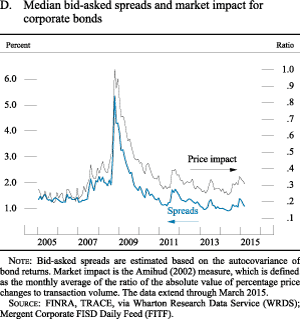
*Note | Accessible Version of Figure D
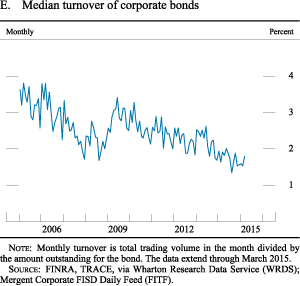
*Note | Accessible Version of Figure E
Some analysts raised concerns that the rise of buy-and-hold investors and the decline in dealer inventories relative to the outstanding amount over the past few years may have negatively affected the prospects for liquidity conditions in the corporate bond market, especially during episodes of financial stress. So far, however, corporate bond market liquidity as captured by conventional measures has not experienced substantial deterioration during recent episodes of stress in fixed-income markets, such as the sharp increase in Treasury rates in the summer of 2013 or the flash rally of October 15, 2014.
Footnotes
1. The SCOOS is available on the Board's website at www.federalreserve.gov/econresdata/releases/scoos.htm. Return to text
2. High-frequency trading refers to computerized trading using proprietary algorithms that often rely on low-latency technology. For a description of the growth of automated trading--HFT in particular--and the associated benefits and risks, see Treasury Market Practices Group (2015), "Automated Trading in Treasury Markets," white paper (New York: TMPG, June), www.newyorkfed.org/tmpg/TPMG_June%202015_automated%20trading_white%20paper.pdf ![]() . Return to text
. Return to text
3. U.S. Department of the Treasury, Board of Governors of the Federal Reserve System, Federal Reserve Bank of New York, U.S. Securities and Exchange Commission, and U.S. Commodity Futures Trading Commission (2015), Joint Staff Report:The U.S. Treasury Market on October 15, 2014 (Washington:Treasury, Board of Governors, FRBNY, SEC, and CFTC, July), www.treasury.gov/press-center/press-releases/Documents/Joint_Staff_Report_Treasury_10-15-2014.pdf ![]() . Return to text
. Return to text
As in the Treasury market, liquidity conditions in the agency MBS market were generally stable. Dollar-roll-implied financing rates for production-coupon MBS--an indicator of the scarcity of agency MBS for settlement--suggested limited settlement pressures in these markets over the first half of 2015 (figure 31).
...as were short-term funding markets
Conditions in short-term dollar funding markets also remained broadly stable during the first half of 2015. Both unsecured and secured money market rates have stayed at modestly higher levels since late 2014 but continued to be close to the average rates observed since the federal funds rate reached its effective lower bound. Secured money markets generally functioned smoothly, but rates in these markets experienced some volatility in the first half of 2015, particularly around quarter-ends, consistent with moderate quarter-end funding pressures. Unsecured offshore dollar funding markets generally did not exhibit signs of stress.
Money market participants continued to focus on the ongoing testing of the Federal Reserve's monetary policy tools. The overnight reverse repurchase agreement (ON RRP) operations have continued to provide a soft floor for money market rates, and the combination of term and ON RRP operations supported these rates around quarter-ends.
Broad equity price indexes and stock market volatility were both little changed, on net, and risk spreads on speculative-grade corporate bonds narrowed slightly
Despite higher interest rates and notable declines in Wall Street analysts' projections for corporate earnings, broad measures of U.S. equity prices were little changed, on balance, over the first half of the year (figure 32). Stock prices for firms in the utilities sector, which are more sensitive to interest rates, fell substantially. Implied volatility for the S&P 500 index, as calculated from options prices, was little changed, on net, and remained below its historical median level.
Corporate bond spreads for investment-grade firms were little changed and stayed close to their historical average levels. Spreads for speculative-grade bonds narrowed modestly--in part because of improvements for energy firms--and are somewhat below their historical norms. (For further related discussion, see the box "Developments Related to Financial Stability.")
Developments Related to Financial Stability
Financial vulnerabilities in the U.S. financial system overall have continued to be moderate since the February Monetary Policy Report. Capital and liquidity positions at the largest banking firms have remained at high levels relative to recent historical standards, and debt growth in the household sector has been modest. However, valuation pressures in many fixed-income markets, while having eased, have stayed notable, prices and valuations for commercial real estate have increased further, and underwriting standards for leveraged loans are still a concern. Moreover, borrowing by lower-rated businesses has continued at a rapid rate. Market participants have expressed a concern that liquidity, especially in fixed-income markets, is now more likely to deteriorate significantly even under moderate stress. However, a variety of metrics do not suggest a deterioration in day-to-day liquidity, with some mixed evidence that may point to less resilient liquidity. The Federal Reserve is watching related developments closely. (See the box "Liquidity Conditions in the Bond Market.")
The financial sector now is likely more resilient to possible adverse events largely because of the increased capital held by the largest banking firms, which reduces the potential spillovers to the macroeconomy from losses in the banking sector (figure A). Regulatory capital ratios of the largest banks are high by recent historical standards, and the stress tests mandated by the Dodd-Frank Wall Street Reform and Consumer Protection Act of 2010 as well as the accompanying Comprehensive Capital Analysis and Review, both of which were completed in April 2015, show that the 31 participating firms would maintain capital ratios above required minimums through a severe recession during a nine-quarter projection horizon. Higher forward-looking capital positions reflect, in part, a decrease in the average credit risk of loans, although underwriting standards have weakened in certain segments. Large firms' liquidity ratios have also improved with the initial phase-in of new liquidity regulations. Estimates of duration gaps for these firms suggest that they have lower sensitivities to higher interest rates than smaller banking firms. All banks, however, face considerable uncertainty regarding the sensitivity of their deposits to rising interest rates, and supervisors have been working with firms to manage this potential risk.
At insurance companies and broker-dealers, capital positions are also relatively high. In addition, secured borrowing and financing by dealers continue to decline, suggesting less short-term funding both for financing clients and for financing inventories that can be used to provide liquidity in markets. The stock of private, short-term, money-like instruments, which form funding intermediation chains that may be vulnerable to runs, has generally hovered at relatively high levels in the past couple of years, though well below crisis peaks. A decline in repurchase agreements has coincided with growth in uninsured deposits. Assets in money market funds have held about steady since the Securities and Exchange Commission finalized reforms in July 2014 to mitigate the funds' susceptibility to investor runs. The reforms are required to be fully implemented by late 2016, and it will be important to monitor their effects.
Valuation measures in most asset markets remain notable, but they are less pronounced in some sectors given the low level of long-term real Treasury yields. Credit markets have been reflecting some signs of reach-for-yield behavior, as issuance of speculative-grade bonds continues to be strong, yields are low, and credit spreads are somewhat narrow by historical standards. Issuance of leveraged loans, while robust, declined in the first half of 2015 on a year-over-year basis. Market participants continue to point to the leveraged lending guidance as having affected the market. Indicators of the underwriting quality of leveraged loans in recent months show a modest improvement, but, overall, underwriting standards remain weak. The share of loans--mostly those for middle-market companies--originated by nonbank lenders reportedly has increased a bit further.
Valuation pressures in commercial real estate are rising as commercial property prices continue to increase rapidly, and underwriting standards at banks and in commercial mortgage-backed securities have been loosening. For residential real estate, prices have risen most rapidly in areas where they fell most in the wake of the financial crisis, and aggregate valuation measures remain close to historical norms. In addition, dealers' responses to the March and June Senior Credit Officer Opinion Survey on Dealer Financing Terms suggest that client demand for secured funding of commercial and residential mortgage-backed securities has been increasing in recent quarters.
Stock prices were little changed, on net, even as earnings forecasts fell and interest rates rose. The equity risk premium--the gap between the expected return and the real 10-year Treasury yield--narrowed further and is now close to historical norms. The possibility that term premiums could revert sharply to more normal levels continues to be a potential risk for asset prices, especially if this reversion were to occur in the absence of positive news about economic growth. Moreover, ongoing concerns that liquidity could deteriorate unexpectedly, in combination with the growth in assets of mutual funds that hold less liquid bonds, suggest that a jump in long-term rates that in turn sparked large bond fund redemptions might amplify volatility. That said, the risk of fire sales is mitigated to some extent by the lower leverage in the financial system.
The ratio of private nonfinancial sector credit to gross domestic product (GDP) is significantly below its peak in 2009 and likely remains below a trend-adjusted level (figure B). The household debt-to-GDP ratio has receded to early 2000 levels. Recent modest increases in household debt continue to mostly reflect the sluggish increases in mortgages for prime borrowers. However, auto and student lending, even to financially fragile households, continued apace, though these are smaller components of total household debt. Measures of leverage for the aggregate nonfinancial business sector have been rising, and they are near the high end of their multidecade range for speculative-grade and unrated firms, indicating a buildup of vulnerabilities.
Large banking firms generally have only limited exposure to areas of the financial system with more notable vulnerabilities, such as segments of the bond and equity markets, and their actions are not contributing materially to higher vulnerabilities in those sectors. Large banking firms' direct net exposures to Greece are low, although financial vulnerabilities from the situation could become more concerning if large European counterparties were weakened by a significant deterioration in peripheral European countries.
As part of its efforts to improve the resilience of the financial system, the Federal Reserve Board and other federal banking agencies finalized a rule last year that introduced a liquidity coverage ratio. The rule requires large and internationally active banking organizations to hold a certain minimum amount of high-quality liquid assets--such as central bank reserves and government and corporate debt--that can be converted easily and quickly into cash. Since the February Monetary Policy Report, the Federal Reserve Board proposed an amendment to that rule that would allow limited amounts of certain general obligation state and municipal bonds to qualify as high-quality liquid assets if they meet the same liquidity criteria that currently apply to corporate debt securities.1 The proposed rule would maintain the strong liquidity standards of the liquidity coverage ratio rule while providing banking organizations with the flexibility to hold a wider range of instruments that would qualify as high-quality liquid assets.
Footnotes
1. For the proposed amendment, see Board of Governors of the Federal Reserve System (2015), "Liquidity Coverage Ratio: Treatment of U.S. Municipal Securities as High-Quality Liquid Assets," Federal Register, vol. 80 (May 28), pp. 30383-89, www.gpo.gov/fdsys/pkg/FR-2015-05-28/pdf/2015-12850.pdf. Return to text
Bank credit expanded and bank profitability improved slightly
Aggregate credit provided by commercial banks increased at a solid pace in the first quarter of 2015 (figure 33). The expansion in bank credit reflected moderate loan growth coupled with continued expansion of banks' holdings of securities. The growth of loans on banks' books was generally consistent with the SLOOS reports of increased loan demand for most loan categories and further easing of lending standards for real estate loans over the first quarter of 2015. Meanwhile, delinquency and charge-off rates continued to improve across most major loan types.
Measures of bank profitability remained below their historical averages but improved slightly in the first quarter of 2015 (figure 34). Several subcomponents of noninterest income increased, although declining net interest margins continued to put downward pressure on the profitability of banks. Equity prices of large domestic bank holding companies (BHCs) have increased modestly, on net, since the end of last year (figure 32). Credit default swap (CDS) spreads for large BHCs were about unchanged on balance.
The M2 measure of the money stock has increased at an average annualized rate of about 6 percent since January, somewhat faster than the pace of nominal GDP growth. Demand for liquid deposits and currency has continued to boost M2 growth.
Municipal bond markets functioned smoothly, but some issuers remained strained
Credit conditions in municipal bond markets have generally remained stable since the end of last year. Over that period, the MCDX--an index of CDS spreads for a broad portfolio of municipal bonds--increased slightly, while ratios of yields on 20-year general obligation municipal bonds to those on comparable-maturity Treasury securities moved down a bit.
Nevertheless, significant financial strains were still evident for some issuers. In particular, Puerto Rico, which continued to face challenges from subdued economic performance, severe indebtedness, and other fiscal pressures, could reportedly seek to restructure at least part of its debt.
International Developments
Sovereign bond yields are higher...
After declining, on balance, during the first few months of the year, sovereign yields in the advanced foreign economies (AFEs) began to climb rapidly in late April (figure 35). In Germany, long-term yields traded at record lows in mid-April, in part in response to the initiation of the public-sector purchase program of the European Central Bank (ECB). However, the 10-year government bond yield subsequently rose about 60 basis points. Most of this rise appeared to reflect an increase in the term premium, which had likely become very low earlier in the year. However, the timing of this increase has no clear explanation. The rise in German yields also appeared to reflect higher expected short-term rates, which rose, at least in part, in response to euro-area inflation data that came in higher than had been expected. (For more discussion, see the box "Monetary Policy and Interest Rates in Advanced Economies.") More recently, however, German yields have moved back down some in reaction to developments in Greece.
Monetary Policy and Interest Rates in Advanced Economies
During 2014, economic prospects in the United States improved, while in some major advanced foreign economies (including the euro area and Japan), data on economic activity disappointed and concerns about deflationary pressures increased. As economic outlooks diverged, so did monetary policies. The Federal Reserve wound down and, in October, concluded the asset purchase program that began in September 2012. In contrast, the Bank of Japan (BOJ) and the European Central Bank (ECB) announced further expansions of their asset holdings (figure A). In October, the BOJ increased the pace of its asset purchases (primarily Japanese government bonds, but also some shares of exchange-traded stock funds and real estate investment trusts) and reiterated that its goal was to raise inflation to 2 percent. In September, the ECB reduced its key policy rates, with the deposit rate falling to negative 0.2 percent, and announced plans to purchase two kinds of private-sector securities: covered bonds and asset-backed securities. Then, in January of this year, the ECB announced an expansion of its asset purchases to include public-sector securities, raising its total asset purchases to €60 billion per month. The ECB indicated that it intends to continue that pace of purchases through September 2016 or until its Governing Council believes that euro-area inflation is on track to meet the target of below, but close to, 2 percent.
Policy easing abroad contributed to a decline in market expectations for future policy rates, especially in the euro area, relative to those in the United States (figure B). The divergence of policy expectations was accompanied by a significant increase in the foreign exchange value of the dollar from mid-2014 to March of this year. That dollar appreciation has likely contributed to the drag that U.S. net exports have exerted on U.S. economic growth in recent quarters. In addition, the rise in the dollar's value has lowered U.S. import prices and thus put downward pressure on U.S. consumer price inflation.
Long-term interest rates abroad declined during 2014 and early 2015 (figure 35). Those declines reflected not only shifting expectations of the path of policy interest rates, but also reductions in the term premiums required by investors to hold longer-term assets. Central bank asset purchases--both expectations of those purchases and their later commencement--appear to explain some, but not all, of the decline in term premiums. Term premiums on German bonds continued to decline following the start of ECB asset purchases in March, and German 10-year bond yields fell to near zero by early April. Since then, however, term premiums and yields on German 10-year bonds have risen sharply, on net, as market participants reassessed the sustainability of the previous substantial declines. These movements in foreign yields and term premiums appear to have spilled over to U.S. yields and term premiums.
Some of the pickup in long-term interest rates abroad since mid-April also likely reflected a modest rebound in market expectations of future policy rates in those countries. Data showed continued economic recovery in the euro area and solid growth in Japan, and the stabilization in oil prices after previous sharp declines reduced concerns over deflation in the advanced foreign economies. Still, market expectations, as implied by quotes from overnight index swaps, suggest that policy rates will remain near zero for quite some time in the euro area and Japan, even as monetary policy begins to normalize in the United States and the United Kingdom (as shown in figure B).
Sovereign yields rose even more in other euro-area countries, especially in Greece. Since the previous report, negotiations among the Greek government, other European authorities, and the International Monetary Fund (IMF) over official financial assistance to Greece have been protracted. In late June, Greek authorities decided to hold a referendum on their creditors' proposals, stalling negotiations and resulting in the cash-strapped Greek government missing a payment of €1-1/2 billion in principal to the IMF. With fears of a potential exit from the euro area and acute problems at Greek banks accelerating withdrawals of Greek bank deposits, Greek authorities declared a bank holiday and imposed capital controls. Negotiations resumed after Greek citizens voted to reject the creditor proposals, but the closure of the banks contributed to a further deterioration of economic conditions in Greece. Over the previous weekend, Greece and its creditors reached a preliminary agreement to begin negotiations on a new financing and adjustment program, subject to Greece completing several prior actions. Greek sovereign spreads spiked at the end of June, and Italian and Spanish sovereign spreads rose modestly. These spreads have since retraced substantially; as a result, Greek spreads remain somewhat wider since mid-February, and Italian and Spanish spreads are little changed.
...and the dollar remains well above levels of a year ago
The foreign exchange value of the dollar rose appreciably in the second half of 2014 and early 2015. It has changed little, on balance, since then (figure 36). The dollar is stronger against emerging market economy (EME) currencies since February, as U.S. yields have risen and concerns about economic prospects for the EMEs mounted.
Equities in Europe and Japan have moved higher this year, buoyed by encouraging macroeconomic data (figure 37). The Nikkei increased roughly 15 percent, boosted by stronger-than-expected consumer price releases and strong corporate earnings in addition to continued quantitative easing. EME equity prices are also generally higher. Notably, the Shanghai Composite index has been unusually volatile. It soared 60 percent in the first five months of 2015, reportedly reflecting repeated monetary policy easing measures and increased investor leverage. However, since mid-June, the index has dropped about 20 percent, on net, even while Chinese authorities have introduced a number of measures to stem the decline, including the People's Bank of China providing direct liquidity support to fund stock purchases.
In numerous foreign economies, economic growth stepped down in the first quarter
Economic growth slowed in the first quarter in many of our main trading partners (figure 38). In China, weakness in exports and the real estate sector led to a significant step-down in GDP growth in the first quarter. Weak exports also constrained growth in Mexico and the United Kingdom. GDP contracted around 1/2 percent in Brazil. And, in Canada, real GDP also contracted in the first quarter, in part because lower oil prices weighed on investment in the energy sector and severe winter weather depressed consumption. Recent economic data for the second quarter have been mixed.
By contrast, in the euro area and Japan, economic growth picked up during the first quarter of 2015, and data thus far point to solid growth during the second quarter (figure 39). Growth in these economies continues to receive support from highly accommodative monetary policies and lower commodity prices. Nevertheless, the situation in Greece remains a concern for the euro area.
After falling significantly at the beginning of the year, foreign inflation began to recover but remained low
Largely reflecting the plunge in oil prices last year, headline inflation fell further early in the year in the AFEs and the EMEs. However, as energy prices rebounded during the first half of the year, monthly foreign inflation readings also began to turn up. Nevertheless, 12-month inflation in a number of major trading partners remained substantially below their central banks' target, including in the euro area, Japan, and the United Kingdom.
In response, foreign central banks maintained highly accommodative monetary policies
A number of foreign central banks eased monetary policy. Some central banks cut policy rates, including those in Canada, China, India, and Korea. In several cases, including in Denmark, Sweden, and Switzerland, these cuts included moves that left policy rates negative. In addition to cutting benchmark rates, the People's Bank of China also lowered the reserve requirement ratio. The ECB launched a program to purchase public-sector securities, and the Bank of Japan continued to purchase assets at a rapid pace. Meanwhile, the Bank of England kept its policy rate at the historically low level of 0.5 percent, where it has been since March 2009.
Footnotes
1. Residual seasonality is the presence of a predictable seasonal pattern in data that have already been seasonally adjusted. For recent discussions of this issue, see Jason Furman (2015), "Second Estimate of GDP for the First Quarter of 2015," Council of Economic Advisers Blog, May 29, https://www.whitehouse.gov/blog/2015/05/29/second-estimate-gdp-first-quarter-2015; and Charles E. Gilbert, Norman J. Morin, Andrew D. Paciorek, and Claudia R. Sahm (2015), "Residual Seasonality in GDP," FEDS Notes (Washington: Board of Governors of the Federal Reserve System, May 14), www.federalreserve.gov/econresdata/notes/feds-notes/2015/residual-seasonality-in-gdp-20150514.html. The Bureau of Economic Analysis discusses its plans to revise seasonal adjustment procedures for GDP in its upcoming annual revision in Stephanie H. McCulla and Shelly Smith (2015), "Preview of the 2015 Annual Revision of the National Income and Product Accounts," Bureau of Economic Analysis, Survey of Current Business (June), www.bea.gov/scb/pdf/2015/06%20June/0615_preview_of_2015_annual_revision_of_national_income_and_product_accounts.pdf. Return to text
2. The SLOOS is available on the Board's website at www.federalreserve.gov/boarddocs/snloansurvey. Return to text
3. The results of the Survey of Primary Dealers and of the Survey of Market Participants are available on the Federal Reserve Bank of New York's website at www.newyorkfed.org/markets/primarydealer_survey_questions.html ![]() and www.newyorkfed.org/markets/survey_market_participants.html
and www.newyorkfed.org/markets/survey_market_participants.html ![]() , respectively. Return to text
, respectively. Return to text
*On August 12, 2015, the ending dates of the data were clarified for figure B in the box "Slack in the Labor Market" (2015:Q2) and for figures D and E in the box "Liquidity Conditions in the Bond Market" (March 2015). Return to text

